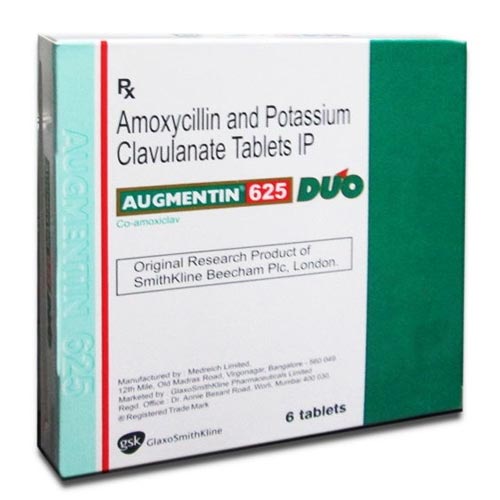Description
Augmentin contains a combination of amoxicillin and clavulanate potassium. Amoxicillin is an antibiotic belonging to a group of drugs called penicillins. Amoxicillin fights bacteria in the body.
Amoxicillin is a broad-spectrum semisynthetic antibiotic similar to ampicillin except that its resistance to gastric acid permits higher serum levels with oral administration.
Clavulanate potassium is a beta-lactamase inhibitor that helps prevent certain bacteria from becoming resistant to amoxicillin.
Amoxicillin/clavulanic acid has been shown to be active against most isolates of the following bacteria:
Gram-Negative Bacteria: Eikenella corrodens, Enterobacter species, Escherichia coli, Haemophilus influenzae, Klebsiella species, Moraxella catarrhalis, Proteus mirabilis.
Gram-Positive Bacteria: Enterococcus faecalis, Staphylococcus aureus, Staphylococcus epidermidis, Staphylococcus saprophyticus, Streptococcus pneumoniae, Streptococcus pyogenes, Viridans group Streptococcus.
Anaerobic Bacteria: Bacteroides species including Bacteroides fragilis, Fusobacterium species, Peptostreptococcus species.
Augmentin is used to treat many different infections caused by bacteria, such as sinusitis, pneumonia, ear infections, bronchitis, urinary tract infections, and infections of the skin.
Pharmacodynamics
Amoxicillin is a moderate-spectrum antibiotic active against a wide range of Gram-positive, and a limited range of Gram-negative organisms. It is usually the drug of choice within the class because it is better absorbed, following oral administration, than other beta-lactam antibiotics. Amoxicillin is susceptible to degradation by β-lactamase-producing bacteria, and so may be given with clavulanic acid to increase its susceptability.
Clavulanic acid, produced by the fermentation of Streptomyces Clavuligerus, is a beta-lactam structurally related to the penicillins. Clavulanic acid is used in conjunction with amoxicillin for the treatment of bronchitis and urinary tract, skin, and soft tissue infections caused by beta-lactamase producing organisms.
Mechanism of action
Amoxicillin binds to penicillin-binding protein 1A (PBP-1A) located inside the bacterial cell well. Penicillins acylate the penicillin-sensitive transpeptidase C-terminal domain by opening the lactam ring.
Clavulanic acid competitively and irreversibly inhibits a wide variety of beta-lactamases, commonly found in microorganisms resistant to penicillins and cephalosporins. Binding and irreversibly inhibiting the beta-lactamase results in a restauration of the antimicrobial activity of beta-lactam antibiotics against lactamase-secreting-resistant bacteria. By inactivating beta-lactamase (the bacterial resistance protein), the accompanying penicillin/cephalosporin drugs may be made more potent as well.
Side effects
All medicines may cause side effects, but many people have no, or minor, side effects.Some medical conditions may interact with Co-amoxiclav.
Tell your doctor or pharmacist if you have any medical conditions.
Common side effects may include: diarrhea, nausea or vomiting, skin rashes or hives, vaginitis.
This is not a complete list of all side effects that may occur. If you have questions about side effects, contact your health care provider.


Reviews
There are no reviews yet.